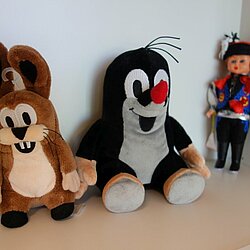In Germany, every child knows him from the television programme "Die Sendung mit der Maus" (The Show with the Mouse). In many other countries in Europe and around the world, he is also a children's star. Black fur, big googly eyes and a red nose: the little mole. In his Czech homeland he is called Krteček. The animator Zdeněk Miler has created about 50 short films with his most famous character. And of course Krteček has a permanent place in the classroom for Czech lessons at the Primary School of the European School Munich.
Czech belongs to the Slavic languages. It is related to the Slovak, Polish, Slovenian or Sorbian languages, among others. As there is no separate Czech language section at the European School Munich, the Czech pupils are part of the international section, the Students without a language section, or SWALS for short. They are enrolled in one of the larger language sections and receive additional Czech lessons. There they learn not only the language, but also Czech history, culture and geography.
Even without ever having learned Czech, most people today know at least one Czech word: "robot". It comes from the 1920 drama "R.U.R - Rossumovi Univerzální Roboti" by writer Karel Čapek, which is about artificial humans who are forced to work and eventually rebel against their creators. The precursor of modern science fiction is still read with pleasure in the original by Czech pupils in the higher grades.
It takes about four hours by car from Munich to the Czech capital Prague - Praha in Czech. It is therefore closer to Munich than the German capital Berlin. At school, of course, the pupils learn about the rich history of the city and the area that now comprises the Czech Republic. Among other things, they learn that Prague became the imperial seat of the Holy Roman Empire in the 14th century under Karel IV (Charles IV) and that the Emperor left his mark on many buildings in the city. They will learn about the Defenestration of Prague, the founding of Czechoslovakia after the First World War and its peaceful partition after the end of the Soviet Union. In addition to the country's eventful history, the schoolchildren also learn about its diverse nature, such as the Bohemian Forest - Šumava in Czech - on the border with Germany with Mount Boubín, which lies in the middle of one of the few remaining primeval forests in Europe.
The classrooms where Czech is taught are adorned with many charts and maps. In Primary School, these help with language learning and there are, among other things, photos of the founder of Czechoslovakia Tomáš Masaryk and the first president of the Czech Republic Václav Havel, so that the pupils can remember the people better.
In addition to Czech culture, the European dimension plays an important role in the lessons. The Czech Republic's ties with neighbouring European countries are not only evident in the country's history, in which there has always been a lot of cultural exchange and mutual influence between Czechs, Slovenes, Slovaks, Poles, Germans, Austrians and Hungarians, among others. The Czech national dish Vepřoknedlozelo is also known and loved in Bavaria: it is a kind of roast pork with dumplings and sauerkraut.
Profile Czech Republic
- Capital: Prague (Praha)
- Population: 10.7 million (2019)
- Bank holidays: 28 October (day of the Czechoslovakian declaration of independence in 1918)
- Accession to the EU: 2004
- The European motto "United in diversity" is "Jednotná v rozmanitosti" in Czech.
- Pupils with Czech citizenship in the European School system: 573.91 (2020)
- You should know this Czech phrase: "Bez práce nejsou koláče" - No work, no cake.




